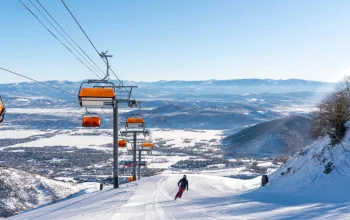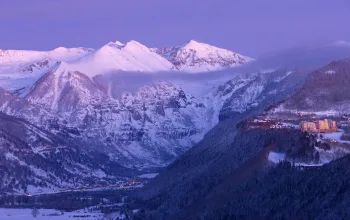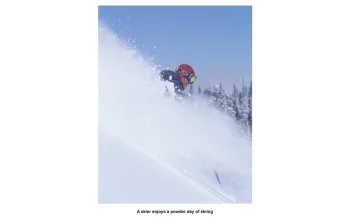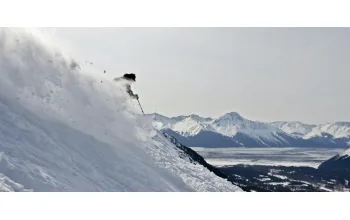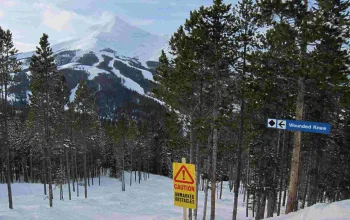A legendary ski centre created in the 1950s by Ernie Blake. Over 50% of the terrain is 'expert' standard, and there is a very highly regarded ski school. The historic town of Taos is 30km/17 miles away.
Mountain
Taos is the most southerly of the major North American ski areas and is famous for its light, desert-dry powder of which an annual average of 305 inches falls. Secondly, and equally important, its famous for its ski school, named after resort founder Ernie Blake, which has a reputation second to none for tuition of skiers at all ability levels. For beginners, tuition is likely to begin at the Strawberry Hill beginners area at the base of the mountain, although it's possible to get around most of the key sectors of the mountain on easy trails once you've perfected those first turns. Beginners will be taught using a technique known as 'Zone therapy' through which they will progress through five zones dividing up the various stages of novice skier progression. Intermediates will enjoy fast cruises down through the trees and a few of the lift served bowls such as Hunkizer or black diamond runs like Blitz and Reforma accessed by the number two lift. Virtually all beginner and intermediate skiing has snowmaking back up in case Mother nature fails to do the business. Experts have more than half of Taos's terrain to enjoy - normally including unpacked powder, trees, glades, bowls, bumps, chutes and wide well-groomed cruisers. Above the tops of the lifts there are dozens of double black diamond extremely difficult trails which can be hiked up to along West Basin Ridge and highline ridge. The highest bowl skiing is beneath Kachina Peak up at 3805m (12,481 feet) - 200 metres above the top of the lifts and giving a skiable vertical of virtually 1000 metres.
Families
Taos takes its responsibilities to its child visitors very seriously. Initially visible with the Kinderkäfig, a large children's center, housing everything to make a child's ski experience exciting and successful. Children have their own ticket counters, ski rental and accessories shop, and cafeteria. With everything self-contained, parents can feel comfortable knowing their kids can get around - and kids feel comfortable doing so. Kinderkäfig instructors specialise in turning children into confident, lifelong skiers by making lessons fun. Junior Elite I classes ease potty-trained 3-to-5-year-olds and older into the sport with a game oriented approach to teaching. Junior Elite II classes are designed to develop and strengthen the skills of 7-to-12-year -olds. The price includes an all-day program, lift ticket, lunch and rentals. Infants and toddlers receive lots of individual attention in the Bebekare and Kinderkare programs. The 2-to-1 staff ratio for infants aged 6 weeks to one year provides babies with lots of attention. A separate nap room and two quiet rooms keep infants cosy. Toddlers between 1 and 2 years old enjoy planned activities and snow play while parents enjoy worry-free skiing. All-day program includes two snacks, lunch and nap time. Half-day includes snack and either snow play or nap time.
Eating Out
There are half a dozen eateries at the ski resort, with a further 100 dotted around the valley, more than half concentrated in the historic town of Taos. Local dishes include chilli, rellenos, posole, enchiladas and tamates. Chillis comes in red or green (choose the combination 'Christmas' dish if you can't decide which you prefer) mild or hot and many of the restaurants have served organic only produce since long before 'organic' was fashionable. Apart from the reputation for organics and either homestyle or gourmet food, the eateries of Taos also have a reputation for their wines, with many offering excellent lists and an annual Festival to boot. New Mexico claims to have the oldest wines in the New World, the Spanish arriving here before they moved on to California. The restaurants at Taos Ski Valley include The Inn at Snakedance, formerly the Hondo Lodge, constructed from century-old massive beams originally used to construct rugged miners' log cabins using trees cleared from the areas which is now the Ski Valley's base area and beginner hill. The Inn has everything from casual fayre to fine dining and is a Winner of the Wine Spectator Award of Excellence, it has weekly wine dinners every Wednesday night throughout the ski season. The Bavarian offers genuine Bavarian/Austrian gourmet cuisine in the elegant log dining room and on the sundeck. Rhoda's and Tenderfoot Katie's in the Resort Center has quick service for breakfast and lunch and table service for lunch and dinner. The Thunderbird Lodge provides gourmet breakfasts, lunches and dinners with a vegetarian selection. Tim's Stray Dog Cantina serves tasty New Mexican cuisine, sandwiches, refreshing margaritas and 'world famous' green chilli cheeseburgers.
Apres
There are no super night spots in Taos Ski Valley itself, although several of the hotels and restaurants lay on live entertainment. Otherwise it is a case of trying different friendly and relaxed bars and other eateries or participating in an organised evening activity like skating, snowmobiling or tubing. For a greater range of evening activities you will need to stay in, or at least travel to historic Taos town.
Boarding
After a 53 year ban, Taos opened for snowboarding in the Spring of 2008. All of the facilities both on and off mountain were upgraded to accomodate snow boarders from classes to rentals and an upgraded terrain park called TSU is ready to host snowboarders and their families.



